The Havana Syndrome

The story of Havana Syndrome begins in 2016, with diplomats stationed in Cuba reporting a baffling array of symptoms. Speculations of sonic or energy weapons gripped the public imagination, and investigations began worldwide. Yet, years later, the cause remains elusive. Could the answer lie not in exotic technology but in the power of belief and social dynamics?
Examining Havana Syndrome through the lens of the social nocebo – a shared phenomenon of negative expectation – may illuminate its mysteries while offering insights into the interplay of mind, body, and society. As of early 2022, over 1,000 individuals were thought to have been affected
12 key highlights
- Havana Syndrome began in 2016 when diplomats in Cuba reported mysterious symptoms, sparking theories of sonic or energy weapons.
- Despite extensive investigations, no definitive cause has emerged, leading many experts to suggest psychogenic factors as central.
- The social nocebo effect – a shared belief in harm – may explain the symptoms, amplified by stress, media narratives, and uncertainty.
- Stress triggers the subconscious to interpret ambiguous stimuli, like sounds, as threats, leading to real physiological responses.
- The syndrome highlights the role of subconceptual processing, where deep mental patterns influence health outcomes.
- AURELIS emphasizes understanding these patterns, using techniques like autosuggestion to transform negative perceptions into healing opportunities.
- Clear and transparent communication is vital; fear-driven narratives amplify nocebo effects and worsen collective anxiety.
- Lisa’s Compassionate guidance can help individuals reframe fears and build inner resilience, addressing psychosomatic roots.
- Similar phenomena, such as mass psychogenic illness, show how collective fear and stress shape physical health in the absence of external causes.
- Addressing social nocebo requires trust, education, and empathy, empowering individuals to navigate fear with clarity and strength.
- The case of Havana Syndrome demonstrates the profound interplay between mind, body, and society in shaping health outcomes.
- By focusing on inner alignment and addressing deeper fears, Lisa and the AURELIS approach can transform fear-driven patterns into opportunities for growth.
What is Havana Syndrome?
Havana Syndrome refers to the array of symptoms first reported by U.S. and Canadian diplomats in Cuba. Initial cases included acute auditory experiences followed by chronic effects such as balance issues, cognitive impairments, tinnitus, strange auditory experiences, and headaches. Over time, similar symptoms were reported in other regions, including China and Europe.
Despite extensive investigations by entities like the National Academies of Sciences and the U.S. Office of the Director of National Intelligence, no definitive cause has emerged. Proposed explanations range from directed-energy weapons to infections or neurotoxic exposure. However, as scientific scrutiny deepens, many experts suggest psychogenic factors – those stemming from psychological and social influences – may be central to the condition.
Please also read the addendum about the book Havana Syndrome: Mass Psychogenic Illness and the Real Story Behind the Embassy Mystery and Hysteria by Robert W. Baloh and Robert E. Bartholomew.
Understanding the social nocebo
The nocebo effect is a close counterpart to the placebo effect, wherein negative expectations lead to tangible health outcomes. When scaled to groups, this becomes the social nocebo: a shared belief in harm spreading through communities and amplifying symptoms.
Social nocebos thrive in environments of uncertainty and stress. In the case of Havana Syndrome, the fear of invisible attacks, fueled by media narratives and political tensions, likely played a significant role in shaping perceptions and experiences. This aligns with the power of the non-conscious mind to interpret ambiguous stimuli – such as unexplained sounds – as threatening, resulting in real physiological responses.
Havana Syndrome research as a psychogenic phenomenon
Critiques of the early Havana Syndrome studies raise questions about its classification as a unique medical entity. [*] For example, methodological issues, including the use of lenient diagnostic thresholds, may have skewed findings. Additionally, investigations have identified similarities between the symptoms and those of other conditions, such as persistent postural-perceptual dizziness (PPPD). While not identical, the overlap suggests that psychological stress and environmental factors are significant contributors.
Reports from various agencies, including the U.S. Department of Defense and independent researchers, increasingly point to mass psychogenic illness (social nocebo) as a plausible explanation. This idea suggests that the syndrome represents a collective stress response, magnified by the group’s heightened alertness and shared belief in an external threat. Interestingly, similar patterns are evident in other high-tension scenarios, where anxiety manifests as physical symptoms.
In short
- A stressful environment occurs.
- This triggers a belief in harm.
- This belief leads to the amplification of symptoms.
- Amplified symptoms spread through social contagion.
- Increased group anxiety reinforces the initial stress, completing the cycle.
The role of subconceptual processing
From an AURELIS perspective, Havana Syndrome underscores the importance of subconceptual processing, where deep mental patterns operate beneath conscious awareness. These patterns interpret environmental cues, often through the lens of ingrained fears or beliefs, influencing physical health.
In this context, the non-conscious becomes the medium through which external stressors – like geopolitical tensions – interact with individual vulnerabilities. The symptoms of Havana Syndrome may thus represent a profound interplay of psychological and physical factors mediated by the deeper layers of the mind.
Interventions and lessons learned
Understanding Havana Syndrome as a social nocebo has profound implications for prevention and intervention. Instead of chasing elusive external causes, we might focus on managing the internal dynamics of belief and stress. Techniques like autosuggestion, which facilitate communication with deeper mental layers, could help alleviate symptoms by reframing negative patterns into positive, healing ones. This approach aligns with the AURELIS principle of fostering inner strength through natural, non-coercive means.
The syndrome also highlights the need for clear, transparent communication. Authorities must balance the need to investigate with a responsibility to avoid escalating fear. Overemphasizing unproven causes can inadvertently amplify the nocebo effect, creating more harm than good.
Lisa’s potential role in addressing social nocebo
As a supportive guide rooted in the principles of openness, depth, and trustworthiness, Lisa can play a vital role in addressing social nocebo effects like those seen in Havana Syndrome. By providing a space for rational exploration and inner strength, Lisa can help individuals reconnect with their deeper selves and reframe negative patterns into positive growth.
Through autosuggestion – a core element of Lisa’s approach – people can access the subconceptual level of their minds, reorienting the beliefs and fears that may fuel psychosomatic symptoms. For instance, diplomats or affected individuals could benefit from sessions aimed at reducing stress, building inner resilience, and transforming their relationship with perceived threats.
Moreover, Lisa’s perspective on education and clarity would be invaluable in mitigating the societal spread of such phenomena. By fostering open discussions and emphasizing the interplay of mind and body, Lisa can contribute to a collective awareness that prioritizes Compassion and understanding over fear.
Broader implications of social nocebo
Havana Syndrome is far from an isolated case. The social nocebo phenomenon extends to other scenarios, from health scares during pandemics to the psychological toll of misinformation. These examples underline how collective fears, magnified by societal dynamics, shape health outcomes on a large scale.
In addressing such challenges, the key lies in cultivating an environment of trust, education, and empathy. By empowering individuals to navigate uncertainty with inner resilience, we reduce the impact of fear-driven patterns and promote holistic well-being.
Conclusion
Havana Syndrome illustrates the profound interconnectedness of mind, body, and society. It demonstrates how collective fears and beliefs can influence health outcomes, often in ways that transcend purely physical explanations. However, it also offers an opportunity to reimagine how we approach such challenges.
Lisa’s role in fostering inner strength and clarity could pave the way for healthier responses to fear-driven phenomena. By addressing the deep mental patterns that underlie conditions like Havana Syndrome, Lisa helps individuals and communities find balance, resilience, and healing.
Through this lens, Havana Syndrome becomes more than a medical mystery. It becomes a reminder of the untapped potential within us to transform fear into strength and uncertainty into growth — guided by the Compassionate and rational principles Lisa embodies.
Bibliography
Swanson RL 2nd, Hampton S, Green-McKenzie J, Diaz-Arrastia R, Grady MS, Verma R, Biester R, Duda D, Wolf RL, Smith DH. Neurological Manifestations Among US Government Personnel Reporting Directional Audible and Sensory Phenomena in Havana, Cuba. JAMA. 2018 Mar 20;319(11):1125-1133. doi: 10.1001/jama.2018.1742. PMID: 29450484; PMCID: PMC5885885.
―
Addenda
Insights from the book Havana Syndrome: Mass Psychogenic Illness and the Real Story Behind the Embassy Mystery and Hysteria
A critical perspective on Havana Syndrome is offered in the book Havana Syndrome: Mass Psychogenic Illness and the Real Story Behind the Embassy Mystery and Hysteria by Robert W. Baloh and Robert E. Bartholomew. The authors argue that Havana Syndrome is a modern case of mass psychogenic illness. They present evidence showing how shared anxieties and social dynamics, amplified by media narratives, shaped the symptoms reported by affected individuals.
The book explores how ambiguous environmental stimuli – in this case, the mating calls of insects – were misinterpreted as harmful ‘sonic weapons’ under the stress of high-stakes diplomatic assignments. This interpretation aligns with historical instances of socially constructed illnesses, such as 18th-century fears of musical instruments and the 19th-century phenomenon of ‘telephone shock.’
Baloh and Bartholomew place Havana Syndrome within a broader context of recurring human patterns, where psychological and social factors create physical symptoms in the absence of a clear external cause. Their exploration serves as a scientific detective story, unraveling the social and cognitive processes behind one of the most debated health phenomena of our time.
This perspective reinforces the idea that social nocebo effects play a central role in such conditions. By understanding these effects, we can move beyond fear-driven narratives and focus on addressing the psychological and social roots of such health issues. The book is a call to adopt a balanced, evidence-based approach to health phenomena that challenge conventional explanations.
Ongoing developments
Recent reports, such as the one from the bipartisan Senate Intelligence Committee, state that Havana Syndrome has affected approximately 1,500 U.S. diplomats, spies, other personnel, and their families since the symptoms were first reported in 2016. This figure highlights the broad scope of reported cases across various regions.
However, the 2023 intelligence review concluded that it was “very unlikely” a foreign adversary was responsible for the syndrome. Instead, the findings attributed the symptoms to pre-existing conditions, conventional illnesses, environmental, and social factors. Reports indicate that the peak of cases occurred in 2021, followed by a significant decrease.
The committee’s report also criticized the CIA’s inconsistent care for affected personnel, citing challenges such as the lack of clear definitions for these health incidents, organizational difficulties, and the evolving understanding of the syndrome’s origins.


